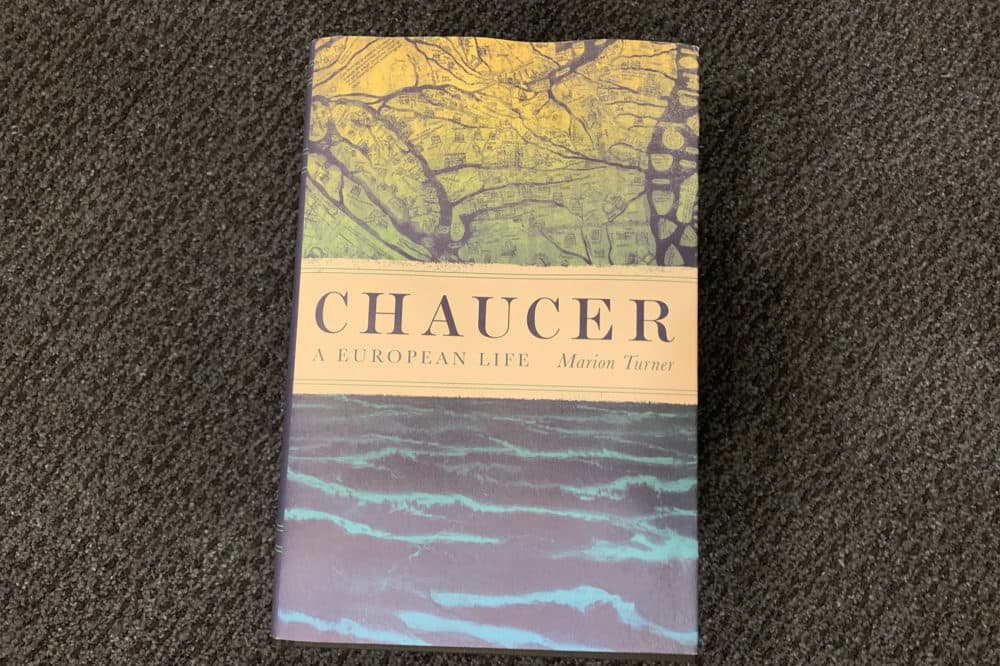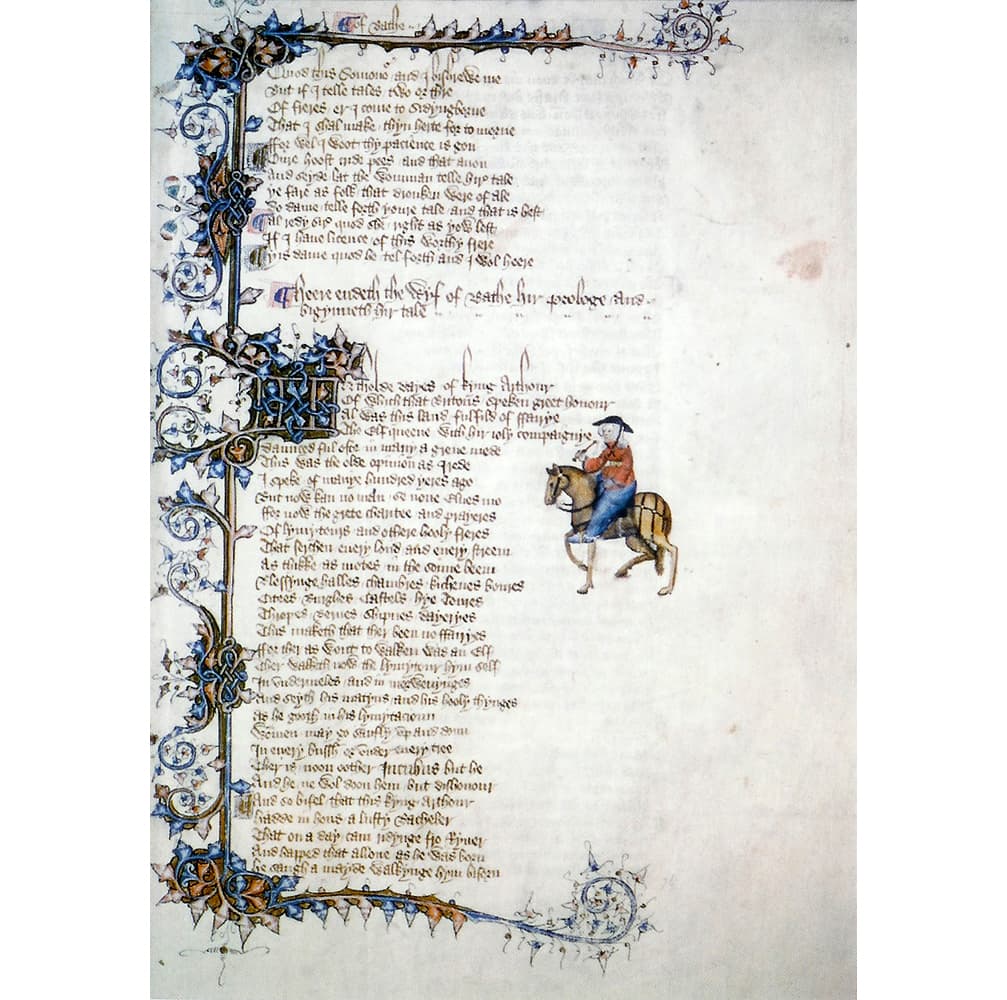Advertisement
Beyond 'The Canterbury Tales,' Geoffrey Chaucer's Life In London

NOTE FOR LISTENERS: Due to issues with our phone lines, we're using a different number for today's broadcast. Please call in at 1-888-899-9287, toll free.
With Meghna Chakrabarti
Before "The Canterbury Tales," Geoffrey Chaucer was a teenage fashion plate, prisoner of war, a traveler. We dig into a new biography.
Guest
Marion Turner, professor at Oxford University’s Jesus College. Author of "Chaucer: A European Life."

From The Reading List
Excerpt from "Chaucer: A European Life" by Marion Turner
On 4th July, 1378, a bead-maker, Simon Wylde de Estland, robbed a haberdasher’s shop in London. The victim, Thomas Trewe, made a list of the items that had been stolen: they included accessories such as caps, laces, threads, and purses, children’s clothes of different colours, musical instruments, cushion-frames, and chess sets complete with pieces described in the terms of medieval affinities as a ‘familia’ (household) or ‘mesne’ (retinue). The range of items suggests a clientele who cared about their leisure time, who thought about appearance and self-fashioning, and who were interested in their children and their domestic surroundings. Notebooks and hats were jumbled up with pictures of the crucifixion painted on fabric and items for use in the Mass.
Several details of this case illustrate aspects of the later-medieval use and understanding of space. The shop was located in the area of Paternoster Row, a street directly north of St Paul’s churchyard. This area was the centre of both the rosary-selling and the book-making trades. Two kinds of products frequently recur in the inventory of stolen items: beads of many different kinds including wood, jet, and black alabaster, and items relating to book-production such as skins of parchment, inkhorns, pencases, quires of paper, and paper covered in leather. People who worked in the same trade tended to cluster together in medieval London and indeed Thomas Trewe’s two formal supporters in his law-suit were also haberdashers (John Salle and Richard Spencer), and the accused worked in an associated trade (bead-making). The specific location of Trewe’s shop is not described by a street address. Instead, it is described by two different markers: parish (St Ewen’s) and ward (Farringdon Within), signifying ecclesiastical and civic jurisdictions. A fourteenth-century house or shop was located under more than one kind of authority, and the property-holder had responsibilities to both ward and parish. As the shop was situated within the city of London itself, the case could be heard under the law of ‘infangthef,’ a privilege that allowed the London mayor and aldermen to exercise summary justice (including execution) on thieves within the city. History, law, convention, and social practice all contributed to the particular character of Trewe’s shop and to the fate of the man that robbed it.
Advertisement
Geoffrey Chaucer was a Londoner, born and brought up a few streets south and east of Thomas Trewe’s place of business. At this time, he resided on the edge of the city, above Aldgate, on the eastern walls of London, but on the day when this case was heard (6th July) he was in Italy, having been sent on a diplomatic mission to Lombardy. This was his second trip to Italy, and he was particularly suitable for these missions because of his urban background. Although by the 1370s he had become a member of the royal household and a retainer of John of Gaunt, his background was mercantile and urban. His upbringing in the city of London had given him the opportunity to mix with Italians and to learn the language. Growing up in a wealthy merchant’s house on the banks of the Thames, watching the ships come in bringing products from all over the world, provided a cosmopolitan childhood for the boy who was to become an exceptionally cosmopolitan poet. Items sold in Trewe’s shop demonstrate the importance of international trade networks for medieval Londoners. Trewe sold a great deal of paper, for instance, which was almost certainly imported from Italy. He also had on sale ‘piper quernes’—pepper mills—to feed the affluent class’s insatiable appetite for pepper, a luxury product that traversed the world. This appetite had provided the foundation of Chaucer’s comfortable upbringing as his grandmother’s first husband had been a pepperer, and she and her subsequent two husbands had continued to live in the heart of the spice traders’ quarter. Chaucer’s life and his poetry were embedded in and determined by a world of international trade, manuscript exchange, multilingual creativity, and the movement of things and ideas across ever-changing borders.
Chaucer evolved from a poet writing imitative dits amoureux (French-inspired love narratives) to a poet of unprecedented innovation and power. His reading was exceptionally varied and he wrote in an extraordinary range of genres. He did all this while holding down numerous day jobs, travelling frequently, and living through events including the Rising of 1381, several parliamentary rebellions, and finally the usurpation of the throne. His life story is a European story, everywhere dependent on the translation—the carrying across—of ideas, texts, and things. It is the story of the development of one of the most surprising imaginations in literary history, an imagination that changed what poetry could do.
Excerpted from CHAUCER: A EUROPEAN LIFE. © 2019 Princeton University Press. Reprinted by permission.
Project Syndicate: "Brexit and the Speaker’s Tale" — "The Speaker of Britain’s House of Commons, John Bercow, is all over the news in the United Kingdom at the moment. And, as the Brexit crisis rumbles on, he has become something of a YouTube star across Europe.
"On March 18, Bercow revived a parliamentary rule from 1604 to prevent Prime Minister Theresa May’s government from bringing the same withdrawal agreement with the European Union back to Parliament after two earlier lopsided votes against it.
"The Speaker’s position goes back much further even than 1604. But, because Bercow’s intervention has changed the trajectory of Brexit, the office has attracted more attention than it has in a very long time. Where did the Speaker come from, and why was the position created during England’s so-called 'Good Parliament' of 1376?
"Back then, the English parliament was already different from others in Europe, because it included a House of Commons with real power, most importantly over taxation. In 1376, the Commons strengthened itself significantly by electing a Speaker, so that it could speak “with one voice” and not be divided or picked off by the more powerful Lords.
"The country was in chaos at the time. King Edward III was senile, and his eldest son (the Black Prince) died during this parliament, leaving a nine-year-old heir.
"Meanwhile, a corrupt coterie was running amok at court. The Commons asserted itself by putting forward a Speaker, emphasizing that 'what one of us says, all say and assent to.' It then invented impeachment in order to condemn the king’s corrupt advisers and his mistress, Alice Perrers."
The Guardian: "The teenage dandy's tale: how a female biographer saw Chaucer afresh" — "He may be revered as the father of English literature, but Geoffrey Chaucer’s first appearance in recorded history is as a teenager wearing leggings so tight one churchman blamed the fashion for bringing back the plague.
"Scholars have known since at least 1966 that Elizabeth de Burgh, who employed the adolescent Chaucer, bought him a 'paltok' for four shillings at Easter 1357, spending a further three shillings for black and red hose, and a pair of shoes. But Chaucer’s first female biographer, the Oxford academic Marion Turner, suggests that no previous biographer had ever considered what a paltok might be. Delving into contemporary chronicles, she found commentators at the time describing paltoks – a kind of tunic – as 'extremely short garments ... which failed to conceal their arses or their private parts.'
"'No one had ever thought about what they were before [but] I found these were completely scandalous items, said Turner, who is associate professor of English at Jesus College, Oxford. 'The paltok was skimpy and scanty, and underneath that there are these long leggings, or tights. Contemporary sources say they emphasised the genitals, as they were laced up very tightly over the penis and bottom, so you could see everything.' "
Stefano Kotsonis produced this hour for broadcast.
This program aired on May 2, 2019.